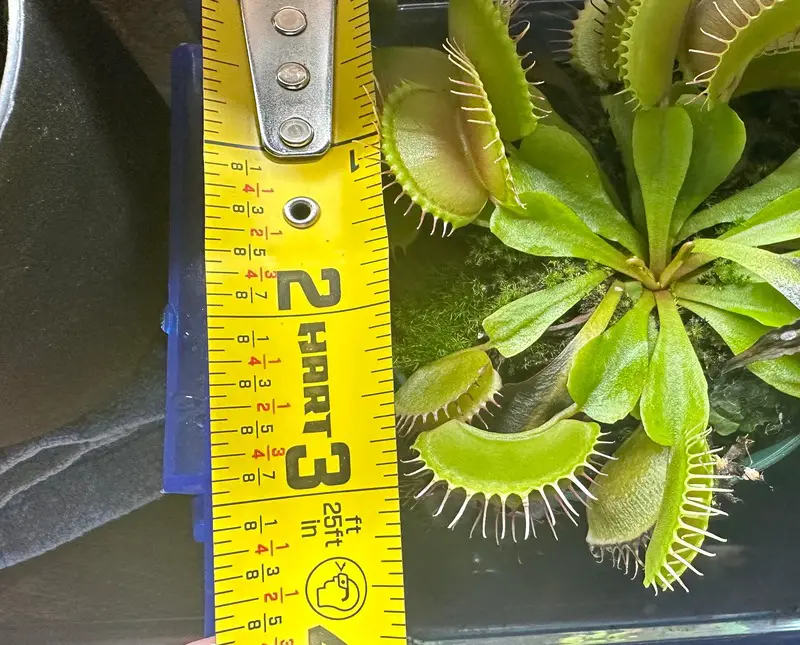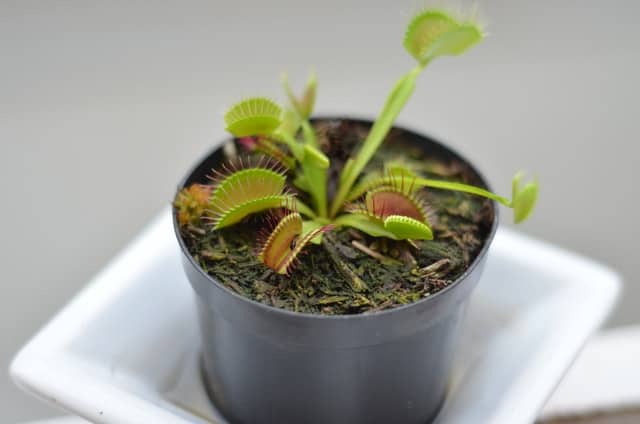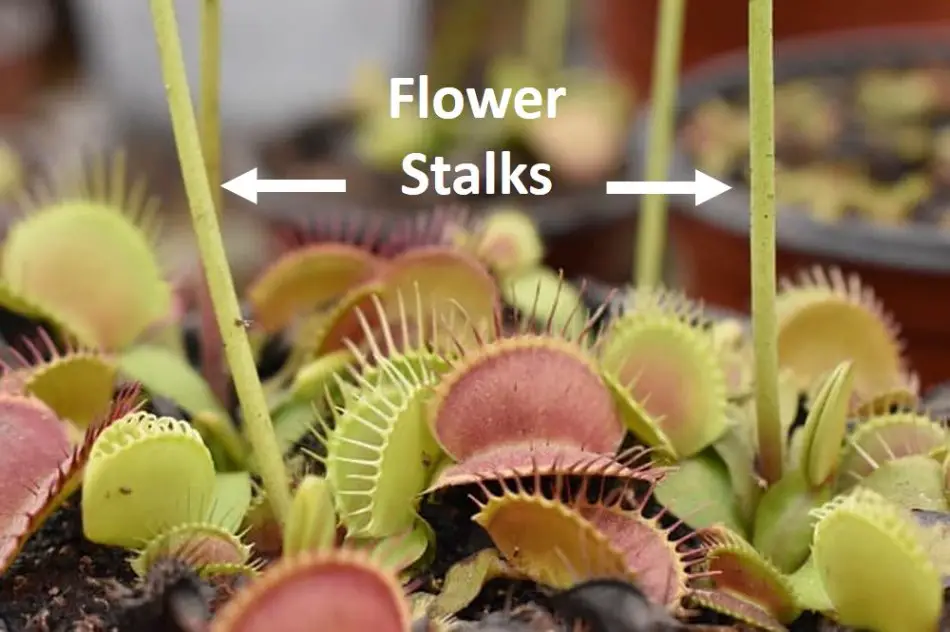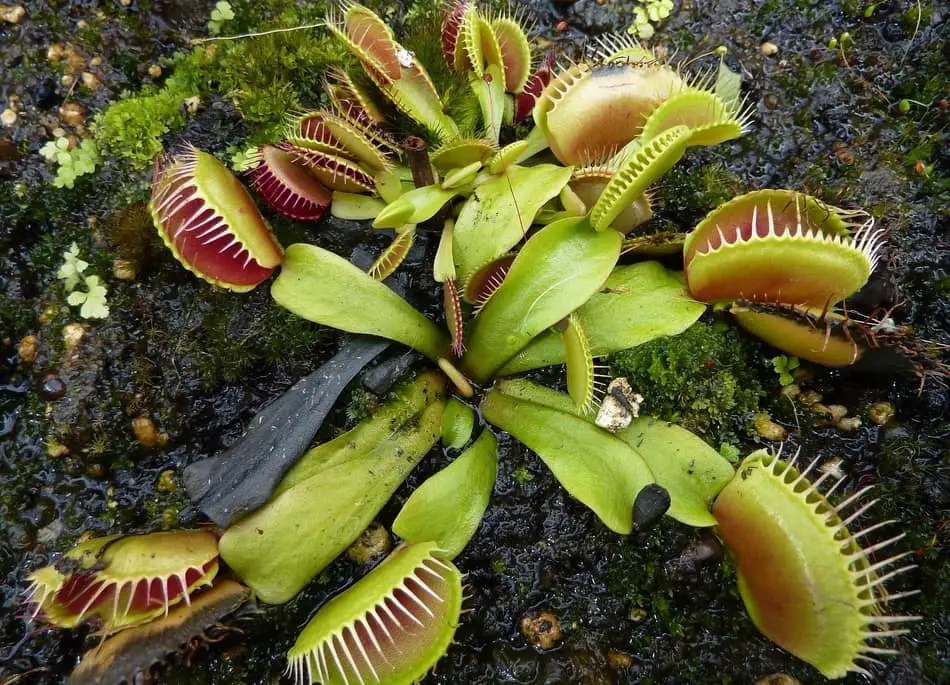Venus flytraps are not especially large plants. They grow in the wetlands of North Carolina and South Carolina. There they grow large enough to capture medium size bugs with their traps.
Mature Venus flytraps can reach a height of a foot, a trap size of one to two inches, and 5 inches in diameter. Some varieties grow upwards, others hug the ground and grow more horizontally than vertically. Proper growing conditions can incentivize growth and some cultivars exhibit larger trap sizes.
These tips will help you grow large and healthy Venus flytraps. Also, remember to check the dimension expectations for your plant, based on the variety and age.
Venus Flytrap Sizing Chart
The Venus flytrap or Dionaea Muscipula is not a large plant. The expected mature dimensions are the following:
- Trap size: 1 inch
- Horizontally: 5 inches in diameter
- Vertically: 1 foot
- Recommended pot diameter: 4-6 inches
- Recommended pot height: 6 inches
Their life cycle starts with very tiny black seeds that grow to become seedlings. The seedlings are also tiny. Some of their traps are only a few millimeters long. As the plant ages, it grows significantly during the first 4 years.
Around year 4 to 6, the Venus fly trap reach its mature size. The plant will also reach overall maturity at the time and start producing flowers every year.
After year 6, the plant will continue to grow, but at a slower rate. Carnivorous plant owners sometimes grow Venus flytraps with traps surpassing the 1-inch average.
| Age | Trap Size | Pot Size (diameter) |
| 0-1 years (seedlings) | Tiny | Any size |
| 1-2 years | 1/8 inch | 2” |
| 2-3 years | 1/4 inch | 3″ |
| 3 years | 1/2 inch | 4″-5″ |
| 4+ years | 1 – 2 inches | 6″ |
Timeline to Grow Large Venus Fly Trap
If you would like to grow Venus Fly Traps to their adult size, keep in mind the life cycle timeline.
It takes 3-4 years for a Venus Fly trap to reach a mature size: a diameter of 5-6 inches and traps that are approximately 1 inch in length.
Many plant nurseries sell Venus Fly Traps that are already adults and are at full size.
Buying already grown Venus Fly Traps is a good strategy if you do not want to wait. Once grown the plant can live for 15+ more years in the proper conditions.

Sizing Through the Seasons
The growth of a Venus flytrap is not necessarily linear (here is more information about each growth stage). Every year they will grow and develop during the spring and summer. Then, in the winter they will experience dormancy. Venus flytrap reduce in size during the dormancy period. Once they exit dormancy, they will slowly recover and continue to grow with more strength thanks to dormancy.
Dimensions of Different Variations
The sizing chart above refers to the standard Venus flytraps we find in the wild. However, there are many different variations of Venus flytraps. Some of them are characterized by their larger size. These are some well-known Venus flytrap cultivars:
- Akai Ryu or Red Dragon
- Dionaea Dente
- King Henry
- Dionaea Green Dragon
- Dionaea Ginormous
- Dionaea B-52
The last two is the list are known for their large traps.
B-52 and Dionaea Ginormous are some of the largest Venus fly trap varieties. Their traps can reach 2 inches in length, which is double the expected size for Venus fly trap.
Dionaea B-52 is often called a giant Venus flytrap. The Dionaea Ginormous is another large specimen of similar dimensions to the B-52 clone.
Consider buying a nice specimen to ensure your plant reaches a good adult size. This article has a list of great online shops.
11 Tips to Grow Big Venus Flytraps
1- Choose the Right Pot
Venus flytraps will experience restricted growth if the pot is not large enough to let them expand. An adult Venus flytrap needs a container that is at least 4 to 5 inches (10.5cm – 12.7 cm) in diameter and more than 6 inches (15.24 cm) deep. Consider choosing a wider pot for Venus flytrap that tend to hug the ground. Also, keep in mind that the depth of the container is the most critical factor. Venus flytraps exhibit large roots that expanding vertically. A lack of vertical space will limit the plant’s growth significantly.
These pots are great for Venus flytraps: https://amzn.to/3IYVGKU.
When you grow seedlings or very young Venus flytraps, you do not have to worry about the pot size. However, as the plant grows it will require a lot more space.
2- Feed Your Plant Healthy Meals
Venus flytraps can survive for months or even years without catching prey. They can do so by fabricating their own food through photosynthesis. However, consuming bugs can give an extra boost to your plant and incentivize growth and development.
Venus flytrap evolved to be successful predators because of the lack of nutrients in their environment. Since they couldn’t obtain key nutrients from the soil, they develop trapping mechanisms to capture bugs. The insects of arachnids that make up their diet provide critical elements to boost their diet. Even though these elements are not fundamental to the plant’s survival. They are very useful as a nutritional supplement.
You can use dehydrated bugs like this to feed your plant following this easy to follow instructions.
Feed your Venus flytrap to provide a boost on their diet and eventually growth. Follow these recommendations to feed your plant:
- Only feed your plant if it is placed indoors. Venus flytrap capture their own prey when placed outdoors.
- Feed one trap of the whole plant at a time. The nutrients obtained from that single bug will provide nutrients for the whole plant.
- Choose feed that is small enough to fit completely inside the chosen trap. A good rule of thumb is to employ bugs that are maximum 1/3 of the size of the lobes.
- Stick to a bug and arachnids diet. Avoid giving Venus flytrap any type of human food such as meat or fruit. Venus flytraps won’t be able to digest those types of food.
- Feed Venus flytrap once every 4 to 6 weeks to avoid overfeeding.
- Do not feed Venus flytraps during dormancy. During this period, the plant does not need extra nutrients.
3- Water From The Bottom
This method is used by plant hobbyists very often to strengthen the roots of their plants. Watering Venus flytraps from the bottom incentivize root growth as the roots have to expand to reach the water source and do some efforts absorbing the water from the very bottom.
Generally, there are two methods of watering plants:
- From the top: Poor water with a container directly in the ground of the pot.
- From the bottom: Place a plant pot with drainage holes on top of a dish. Then fill up the dish a few centimetres. Then, wait until the plant absorbs the water from the dish.
Each method has different benefits. For example, watering from the top helps clean up the soil and avoid mineral deposits in the soil. Besides, watering from the top is standard and very easy. Water from the bottom also provides some key benefits, such as overwatering prevention.
Watering Venus flytrap from the bottom is not a difficult task. Follow these instructions to implement it:
- Make sure your Venus flytrap container has a drainage hall
- Place the pot on top of a shallow plate
- Fill out the plate with water. In this case, since it is a Venus flytrap. It must be pure water: distilled, reverse osmosis or rainwater. You can also use filtered water, but only if you are able to remove all the minerals with this ZeroWater filter.
- Make sure the plate does not contain more than an inch of water.
- Let your plant absorb the water
- Water your plant again once the soil is almost dry, but not quiet.

4- Do Not Let Your Plant Flower
In the spring, Venus flytraps undergo a flowering season. Like most plants, they produce their flowers with the purpose of reproduction.
It is recommended to cut off the flower stalks of Venus flytraps before they flower to keep your plant healthy and promote growth. The production of flowers won’t hurt your plant directly, but it will weaken it significantly. A Venus flytrap spends significant amounts of energy producing those flowers every year. The plant can employ that same energy in growing.

If you are not planning on harvesting seeds, most carnivorous plant growers recommend to cut off those flower stalks as soon as you can spot them. Each plant produces several flowers throughout the season. The flower stalks are easy to spot as they are thick cylindrical structures (very different from regular leaves. The sooner you cut them off the better, the most energy the plant will save.
Beginner Venus flytrap owners are also encouraged to avoid the flowering process as they tend to make key care mistakes. Improper growing conditions can kill the plant, especially after the flowering process, when the plant has weakened significantly.
5- Prune the Black Leaves
Venus flytraps are continuously changing leaves. Old leaves turn black and wither while new ones spur from the center of the bulb. In the wild, black leaves decompose at a faster rate due to the presence of microorganisms in the soil. But, in a plant pot, it can take months for a single dead leave to decompose.
Trim the black leaves in your Venus flytrap periodically to clear up space, avoid overcrowding, and promote the growth of new leaves. There is no need to prune a single plant every week, but a monthly trimming can help with their overall development. Besides, from overcrowding prevention, trimming black leaves will help get rid of extra weight in your plant. Since the leaves are still attached, your plant has to bear with the extra unwanted weight.
6- Let Your Plant Experience Dormancy (Every Year)
Every winter, Venus flytraps must undergo dormancy. The dormancy period is very similar to hibernation. During several months the plant goes into a resting stage. Dormancy is crucial for plant development. If a Venus flytrap skips dormancy for a couple of years, its life span will shorten significantly. The plant will die within the next 2-3 years.
Ensure your plant experiences dormancy every year. In late fall or winter, place your plant in a strategic location where it can have exposure to temperatures between 32 F and 45 F (0 C to 7.2 C). After a couple of weeks, your plant should go dormant and remain at that stage for 3 to 4 months.
It is fairly easy to determine if your plant is dormant. During the spring and summer, Venus flytraps exhibit vibrant color. During dormancy, they look very different. The plant starts losing leaves and it will shrink is size. It is ok for it to be looking down. It is just part of the process.
7- Separate Multiple Plants due to Bulb Root Reproduction
Venus flytraps grow 3 to 10 traps at a time. Any plant that exhibits more than 8 or 10 traps, might not be a single plant anymore. Venus flytraps employ several methods of reproduction including sexual and asexual. Bulb root reproductions is an asexual method for Venus flytrap.
With bulb root reproduction the roots of the plant extend in the ground and create a second bulb root. Then, a new plant grows from the bulb. It is possible to separate both bulbs and end up with two Venus flytraps.
When a large Venus flytrap has produced a young bulb root, the plant will experience some limitations in terms of growth. For example, it will have to share space and resources. As the new plant grows larger, the more mature plant won’t have much growth opportunity.
Consider separating both plants during repotting. You will end up with two individual Venus flytraps. When the plants grow in individual container, they will have a better chance of reaching larger sizes and straightening.
8- Avoid Soil Compression by Repotting Sporadically
The longer soil is set in a pot, the more compressed is going to get, especially if water frequently. The roots in Venus flytraps will struggle to expand if the soil is highly compressed. Consider repotting your plant sporadically to avoid soil compression.
Repotting any plant will weaken it for a few weeks, but it is only a matter of time until the plant recovers and starts thriving in the fresh soil. Consider repotting your Venus flytrap once a year to avoid ground compression (here is a guide on how to pot your plants) (here is a guide on how to pot your plants). It is recommended to repot Venus flytraps at the end of the dormancy period, so they start the growing season in fresh ground.
9- Choose a Breathable Soil Mix
Another important factor to promote root growth and avoid soil compression is to choose the appropriate soil mix. Venus flytraps need nutrient-free mineral-free soil to live. Many Venus flytrap owners employ pure long-fibered-sphagnum moss or peat moss. These are good choices, but employing pure moss as a soil choice does not prevent soil compression. Other elements such as sand or perlite can help air and break up the ground. Also, they help with drainage and prevent the growth of mold and bacteria.
Here is a carnivorous plant soil you can use that is completely safe.
Mix one type of moss either long-fibered sphagnum moss or peat moss with sand or perlite. Some good ratios are 2:1 or 4:1, with more moss than sand or perlite. These soil combinations will stimulate Venus flytrap roots to grow and strengthen.
10- Provide Proper Lighting
Proper lighting is one of the most important requirements of Venus flytraps. Inadequate lighting does not kill Venus flytrap instantly, but it weakens them and can eventually kill them. Venus flytraps without access to enough light will never grow appropriately.
The more light Venus flytraps receive, the better. Optimally Venus flytraps should receive 12 hours of direct sunlight a day. They can live healthily with exposure to only 4-6 hours of sunlight, but that is close to the minimum requirement. Venus flytraps sometimes can help you determine if they are receiving enough sunlight. The inside of the traps of Venus flytrap turns deep burgundy when they are getting plenty of light. Some varieties of Venus flytraps never exhibit the red coloring inside the traps, but the majority do.
Consider supplementing the lighting requirement of your plant with artificial light to encourage their growth. High Output fluorescent lights are good candidates for Venus flytraps. Also, you can employ high power LED plant lights like this one: https://amzn.to/3oJ5Rii.
11- Chose a Large Variety of Venus Flytrap
Not all Venus flytraps are meant to reach the same dimensions. Generally, the height of the plant won’t vary too much, but the size of the traps can vary significantly.
The B-52 variety is considered to be a giant Venus flytrap cultivar as their traps easily reach two inches in length. This plant can capture bugs than the other varieties of Venus flytraps. Still, it is not considered to be the largest type of Venus flytrap. There are other cultivars that reach larger dimensions. For example, the Dionaea Ginormous cultivar exhibits larger traps. The only downside is choosing this cultivar is their trapping mechanisms. Since their traps are so large, sometimes they do not function properly.

Final Thoughts and More Care Instructions
If you are interested in growing large Venus flytraps, remember that there is a dimension limitation. Venus flytraps are not meant to be giant plants. I recommend starting by buying B-52 cultivars. Such plants, exhibit beautiful, and large traps. besides that, you must give it time. Venus flytraps live for years and they continue to grow through their lifetime.
Make sure to implement the tips described in this article and grow healthy plants. Here is a helpful summary on care instructions I use:
Light: Optimally they should receive 12 hours of sunlight, and the minimum is 6 hours of light. The light source might be natural light or artificial lighting (plant lights)
Water: Venus flytraps must be watered with pure water only, such as rainwater, distilled water, and reverse osmosis water. Tap water and bottled water kill carnivorous plants.
The soil of the plant must always remain moist. Always keep the ground humid, but do not flood. Venus flytraps do not grow in swamps.
Soil: Employ nutrient-free soil for carnivorous plants. Never employ enriched soil, full of fertilizers. This article covers many soil options for Venus flytraps.
Feeding: Venus flytraps do not need to capture insects to survive, but they benefit from them greatly. Place Venus flytraps outdoors, and they will have plenty of access to food. Also, consider feeding your plant to provide extra nutrients.
Fertilizers: Do not fertilize Venus flytraps. The chemicals in the fertilizers can hurt the plant
Flowers: After reaching maturity, Venus flytraps start producing flowers every spring. Skipping it allows for further growth and development.
Dormancy: Venus flytraps must undergo a dormancy period for 2-3 months during the winter. Ensure your plant will experience this resting period by placing them in a cold location. For example, outdoors, in a cold garage, or porch.
Recommended Products for Growing Carnivorous Plants
Finding the best pots, lights, and soil for carnivorous plants is difficult. I have grown carnivorous plants for over 5 years, and these are the products I use. The links will take you to Amazon to view the prices and full specs:
- Carnivorous Plant Soil
- Carnivorous plant soil: https://amzn.to/422yLZa
- Artificial Lighting
- Small plant light for 1-2 plants: https://amzn.to/3oQsmSj
- T8 LED light fixture for multiple plants (6500k Cool White): https://amzn.to/3uWoeh2
- Pots and Miscellaneus
- Nursery pots for single plants: https://amzn.to/3oL8YGq
- TDS meter to measure water quality: https://amzn.to/3g8VKLI
- Dried crickets to feed carnivorous plants: https://amzn.to/34QEnKv

